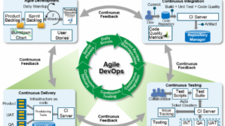Why a combination of agile and DevOps is essential in propelling digital transformation

Limited Time Offer!
For Less Than the Cost of a Starbucks Coffee, Access All DevOpsSchool Videos on YouTube Unlimitedly.
Master DevOps, SRE, DevSecOps Skills!
Source:- itproportal.com
It’s no surprise that the current appetite for agile and DevOps is immense, largely driven by the pressures of the app economy and the need to deliver optimal customer value. Businesses are transforming the way in which they design, develop, and deliver applications so they can offer higher quality apps to customers, faster than ever before.
In this environment, software development processes such as agile and DevOps practices, have become crucial to digital transformation success.
Organisations want – and need – both in order to change the way they deliver value to their customers, introduce innovative digital experiences that increase their brand value, and ultimately grow revenues.
However, as I meet with organisations of all sizes, what strikes me is the disparity in deployment of both agile and DevOps. In some situations, organisations are adopting an agile methodology to add the voice of the customer early on to the development cycle, but have not yet implemented DevOps to promote collaboration and improve the speed and quality of application delivery. Or it can be the other way round, and sometimes they are better at one than the other. From my experience, the appetite for both is there, they just need help digesting them.
Agile and DevOps practices are far more successful when they are used in unison, and they both need to form part of every organisation’s DNA. Scale them together and you accelerate speed to market further, adapt to change in the application economy faster, and build more amazing customer experiences.
Here’s the proof. New research commissioned by CA Technologies shows that 67 per cent of UK organisations using an agile methodology experience an improvement in customer experience.
It also highlights how DevOps and agile are better together than apart: Organisations that add DevOps practices to an agile environment improve new business growth by 38 per cent more than using agile alone. Agile and DevOps together also increase operational efficiency by 23 per cent, compared to using agile alone.
However, organisations need to do more than simply launch both in unison and assume great customer experiences will emerge. They need to mature their agile and DevOps deployments as quickly as possible, because that’s where the greatest payback lies.
Looking again to the research, it reveals that advanced agile users experience a 64 per cent improvement in the time to act on new opportunities (from 19.7 to 7.1 weeks), compared to 26 per cent for basic users, while advanced DevOps users see a 38 per cent improvement in speed to market (from 12.4 to 7.7 weeks), compared to 24 per cent for basic users.
How can DevOps and agile be scaled at similar speed?
I often get asked: How can my organisation quickly scale agile and DevOps, maturing both as quickly as possible to capitalise on the advantages offered by business transformation and the app economy?
From my experiences, there are three key steps to scaling agile and DevOps at the speed of business:
1. Measuring business impact is crucial. It’s too easy to be persuaded by the power of internal measures like lower IT costs or increased productivity to measure the impact of your agile and DevOps practices. Of course, these metrics matter—but not nearly as much as the external indicators that drive business growth, such as customer satisfaction, customer experience, and revenue growth.
2. You have to remove the silos in development and operations. This fragmented approach to application delivery makes it harder to share knowledge and best practices. DevOps is all about collaboration—and this doesn’t happen in silos. To be truly effective, a ‘DevOps mindset’ must be embedded in the culture of your IT function.
3. Organisations need to address the skills gap. According to our research, 72 per cent of EMEA organisations would find it hard to recruit or retain core development talent if they didn’t have an agile approach. If you have people who understand the practices and tools, and have demonstrated the capacity to be adaptable to new ways of working, you will accelerate the necessary culture change.
Tackle technical debt with agile and DevOps
As I talk to different organisations, it is also clear that many have deep concerns about the extra development work incurred by using code that is easy to implement in the short run, instead of applying the best overall solution. When the code carries a lot of technical debt, development based on DevOps practices remains a bottleneck, and business transformation is delayed.
It doesn’t need to be this way. Active management of technical debt can be incorporated into an agile workflow, by measuring debt as part of continuous integration, then using baselines and policies to prevent new debt being introduced and to manage down existing debt. That way, debt is reduced, development accelerates, and new products and services delivering a great customer experience get to market more quickly.